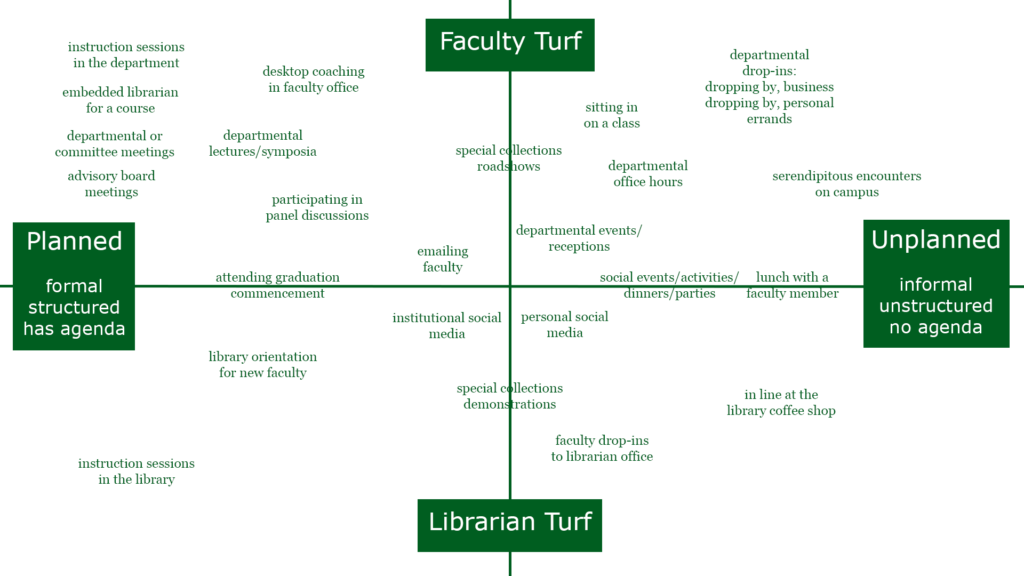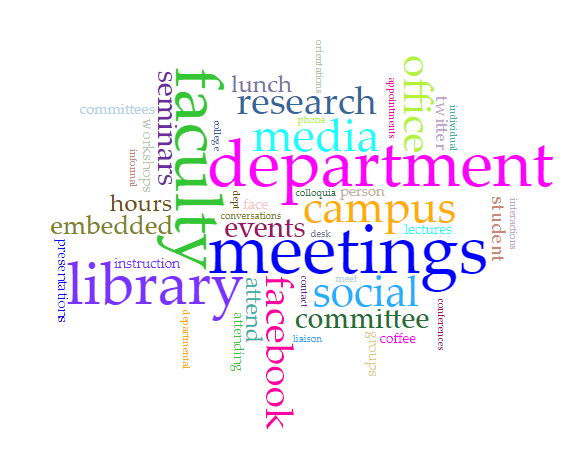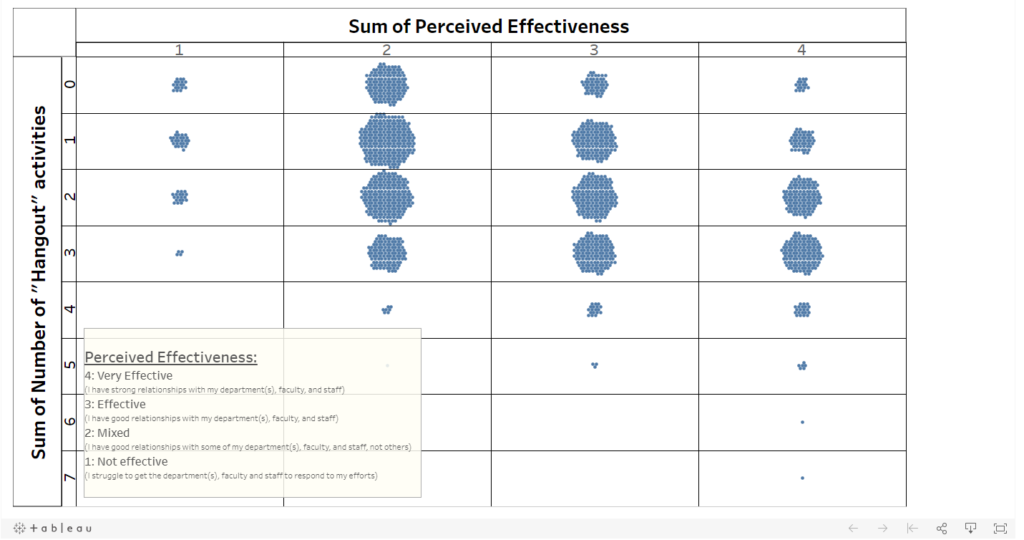At the ACRL 2019 conference, my colleague Sha Towers and I presented a digital poster titled “Embracing the Hangout Factor in Liaison Work.” You can find out more about this research here.
Introduction
What is this all about?
- Academic library liaison programs have moved from a collections-centric to an engagement-centric model (Church-Duran, 2017; Jaguszewski & Williams, 2013; Kennedy, 2014; Kozel-Gains & Stoddart, 2009).
- This means that librarians need new skills and competencies, such as flexibility and creativity (Díaz, 2014; Rodwell & Fairbairn, 2008).
- One of the core competencies is relationship-building (Anthony, 2010; Chung, 2010; Díaz & Mandernach, 2017).
- Relationship building encompasses a lot of different types of activities, which can include social and informal activities as well (Díaz & Mandernach, 2017; Miller, 2014; Silver, 2015).
- The literature includes a few examples of people who have engaged in these types of social and informal activities (Kasperek, Johnson, Fotta, & Craig, 2007; Kinnie, 2002).
- In this research, we take a closer look at these social and informal activities, which we are calling the “hangout factor” in liaison work.
Definition of “Hangout”
What does it mean to “hangout” with faculty or students in liaison work?
- Hangout encompasses the social and informal activities that can be a part of liaison work, but it also can happen during more formal activities too.
- While hangout is networking, not all networking is hangout.
- While hangout activities are face-to-face contact (whether that’s formal – in a classroom, or informal – at a social activity), some hangout can happen in social media spaces as well.
- Hangout involves people/relationship skills, risk taking, being comfortable with ambiguity and playfulness.
Matrix of Liaison Activities by Formality and Location

Theories
What did our matrix exploration lead us to believe about liaison interactions?
- More of the hangout activities take place on “faculty turf” or outside the traditional haunts of the librarian, which means good things can happen when we step outside of our comfort zone.
- Informal hangout activities can have a positive influence on the number and quality of the more formal liaison activities (such as collection requests, information literacy instruction, requests for collaboration, etc.)
- Creating good relations with faculty through hangout type activities is necessary to bring about successful collaborative work.
“Hangout” in Action
What are some examples of “hangout” in action?
- The following stories are some examples of “hangout” in action that we have experienced or taken part in.
- If you would like to record and upload your own stories, please use the QR Code or link below to do so.

Subject Liaison Data
What did our exploration of the Subject Liaisons in Academic Libraries” dataset discover about the “hangout factor”?
(Nero & Langley, 2017)
- This 2015 open access dataset surveying academic library liaisons asked a few questions which are pertinent to our research.
- The first question was Q25: “How do you interact with your department(s), faculty, staff?” Several of the answers can be plotted on the matrix in the unplanned or faculty turf areas: cold call/pop-in, event/party and departmental meeting.
- However, in the free response area the hangout factor abounded.

- We coded the free responses to include in person, social media, informal/casual, impromptu, office hours in the department, and personal connections, among others.
- The second question we were interested in was Q26: “How effective do you think your outreach is?” Possible answers were 1) very effective 2) effective 3) mixed 4) not effective and 5) too early to know.
- We analyzed the data to determine if someone who answered how they interacted with their departments (Q25) with more examples of “hangout” activities (either as one of the choices or in the free response), would think that their outreach was more effective (Q26).

- Ultimately, we determined that this dataset did not adequately answer the questions we had, because of the availability in the dataset of the answer “mixed” when it comes to effectiveness. 40% of respondents chose Mixed – or “I have good relationships with some of my departments, faculty, and staff, not others,” which honestly, could be the answer for many liaisons who have responsibilities for multiple departments.
- However, the many “hangout” free responses to the question of “How do you interact with your departments?” underlined that many liaisons already recognize that “hangout” activities in liaison work are important to engagement.
Best Practices
What suggestions do we have for professional practice?
- Keep your eyes open to recognize hangout opportunities as they arise
- Stretch outside your comfort zone and experiment with different kinds of hangout activities
- View hangout activities with a long lens to see the cumulative effect
- Record and assess the hangout activities as you would other more traditional liaison activities
- Accept hangout activities in and of themselves; don’t stigmatize them as “not real library work.”
References
Anthony, K. (2010). Reconnecting the disconnects: Library outreach to faculty as addressed in the literature. College & Undergraduate Libraries, 17(1), 79–92. https://doi.org/10.1080/10691310903584817
Chung, H.-D. (2010). Relationship building in entrepreneurship liaison work: One business librarian’s experience at North Carolina State University. Journal of Business & Finance Librarianship, 15(3/4), 161-170. https://doi.org/10.1080/08963568.2010.487432
Church-Duran, J. (2017). Distinctive Roles: Engagement, Innovation, and the Liaison Model. Portal: Libraries and the Academy, 17(2), 257-271. https://doi.org/10.1353/pla.2017.0015
Díaz, J. O. (2014). The roles of engagement at the Ohio State University Libraries: Thoughts from an early adopter. The Reference Librarian, 55(3), 224-233. https://doi.org/10.1080/02763877.2014.910741
Díaz, J. O., & Mandernach, M. A. (2017). Relationship building one step at a time: Case studies of successful faculty-librarian partnerships. Portal: Libraries and the Academy, 17(2), 273-282. https://doi.org/10.1353/pla.2017.0016
Jaguszewski, J. M., & Williams, K. (2013). New roles for new times: Transforming liaison roles in research libraries. Association of Research Libraries. Retrieved from http://www.arl.org/publications-resources/2893-new…
Kasperek, S., Johnson, A., Fotta, K., & Craig, F. (2007). Do a little dance: The impact on students when librarians get involved in extracurricular activities. The Journal of Academic Librarianship, 33(1), 118-126. https://doi.org/10.1016/j.acalib.2006.06.006
Kennedy, A. R. (2014). Leveraging the liaison model: From defining 21st century research libraries to implementing 21st century research universities. Ithaka S+R. Retrieved from http://www.sr.ithaka.org/blog/leveraging-the-liais…
Kinnie, J. (2002). Making a case for the tenure banjo. American Libraries, 33(10), 58.
Kozel-Gains, M. A., & Stoddart, R. A. (2009). Experiments and experiences in liaison activities: Lessons from new librarians in integrating technology, face-to-face, and follow-up. Collection Management, 34(2), 130-142. https://doi.org/10.1080/01462670902729150
Miller, J. (2014). A method for evaluating library liaison activities in small academic libraries. Journal of Library Administration, 54(6), 483-500. https://doi.org/10.1080/01930826.2014.953387
Nero, N., & Langley, A. (2017). Subject liaisons in academic libraries: An open access data set from 2015. Portal: Libraries and the Academy, 17(1), 5-15. https://doi.org/10.1353/pla.2017.0001
Rodwell, J., & Fairbairn, L. (2008). Dangerous liaisons? Defining the faculty liaison librarian service model, its effectiveness and sustainability. Library Management, 29(1/2), 116-124. https://doi.org/10.1108/01435120810844694
Silver, I. D. (2015). For your enrichment: Outreach activities for librarian liaisons. Reference & User Services Quarterly, 54(2), 8-14. https://doi.org/10.5860/rusq.54n2.8